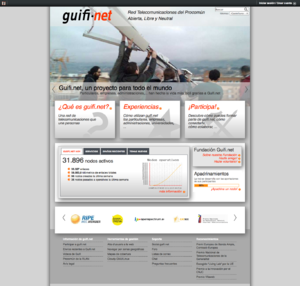Difference between revisions of "Guifi.net"
| Line 3: | Line 3: | ||
== <small>'''Self-portrait'''</small> == | == <small>'''Self-portrait'''</small> == | ||
| − | '' | + | ''What is guifi·net?'' |
| − | ''guifi·net | + | ''guifi·net is a bottom-up, citizenship-driven technological, social and economic project with the objective of creating a free, open and neutral telecommunications network based on a commons model. The development of this common-pool infrastructure eases the access to quality, fair-priced telecommunications in general and broadband Internet connections in particular, for everybody. Moreover, it generates a model for collaborative economic activity based on proximity and sustainability.'' |
| − | '' | + | ''The technological project'' |
| − | ''- | + | ''guifi·net started in 2004 as a telecommunications technological project in the Osona county (Catalonia, Spain) to solve the broadband Internet access difficulties in rural areas, given the lack of traditional operators to provide services there. By means of radio links built with commodity WiFi routers, the neighbours deployed their own network to interconnect different locations (the so-called nodes) such as houses, offices, farms, public buildings, etc. to be able to access telecommunications and the Internet wherever they needed: at home, at work, in the library, etc.'' |
| − | '' | + | ''As of December 2016, guifi·net accounts for more than 32.500 operating nodes, most of them in Catalonia, but also many others in the Valencian Community, the Balearic Islands, Madrid, Andalusia, Asturias, the Basque Country... Nowadays, hundreds of homes and offices access the Internet by means of guifi·net's fiber optics connections and thousands do so via radio links. It is estimated that more than 50,000 people are serviced through the commons-based network.'' |
| − | '' | + | ''Since 2008 guifi·net is, through the guifi·net Foundation, a telecommunications operator registered at the Telecommunications Operators Register run by the Spanish National Market and Competence Comission, participates as an AS (Autonomous System) in the Internet and exchanges traffic at up to 30 Gbps in CATNIX, the Internet Exchange Point (IX) of Catalonia.'' |
| − | + | (https://guifi.net/en/what_is_guifinet) | |
| − | |||
| − | |||
| − | |||
| − | |||
| − | |||
| − | |||
== <small>'''Description'''</small> == | == <small>'''Description'''</small> == | ||
Revision as of 00:40, 3 June 2017
Contents
Self-portrait
What is guifi·net?
guifi·net is a bottom-up, citizenship-driven technological, social and economic project with the objective of creating a free, open and neutral telecommunications network based on a commons model. The development of this common-pool infrastructure eases the access to quality, fair-priced telecommunications in general and broadband Internet connections in particular, for everybody. Moreover, it generates a model for collaborative economic activity based on proximity and sustainability.
The technological project
guifi·net started in 2004 as a telecommunications technological project in the Osona county (Catalonia, Spain) to solve the broadband Internet access difficulties in rural areas, given the lack of traditional operators to provide services there. By means of radio links built with commodity WiFi routers, the neighbours deployed their own network to interconnect different locations (the so-called nodes) such as houses, offices, farms, public buildings, etc. to be able to access telecommunications and the Internet wherever they needed: at home, at work, in the library, etc.
As of December 2016, guifi·net accounts for more than 32.500 operating nodes, most of them in Catalonia, but also many others in the Valencian Community, the Balearic Islands, Madrid, Andalusia, Asturias, the Basque Country... Nowadays, hundreds of homes and offices access the Internet by means of guifi·net's fiber optics connections and thousands do so via radio links. It is estimated that more than 50,000 people are serviced through the commons-based network.
Since 2008 guifi·net is, through the guifi·net Foundation, a telecommunications operator registered at the Telecommunications Operators Register run by the Spanish National Market and Competence Comission, participates as an AS (Autonomous System) in the Internet and exchanges traffic at up to 30 Gbps in CATNIX, the Internet Exchange Point (IX) of Catalonia.
(https://guifi.net/en/what_is_guifinet)
Description
Guifi.net is an open, free and neutral commons telecommunications network operating via nodes in Spain (mainly in Catalonia and Valencia). The network is structured by wireless connections built and funded by its own users, following an open model under the condition of not harming other users or the networks own function.
Usually, networks are star-shaped, but guifi.net is a grid structured around a main line connected to nodes activated by individuals, businesses and administrations, purposefully extending coverage over areas where infrastructure is hard to access.
The project was conceived April 3rd, 2004 by a group of people concerned with solving the internet access difficulties in rural areas, associated with high costs and geographic restrictions. August saw the first fiber optics release, a project called Fiber For the Farms (FFTF) covering 2 km linking dozens of farms in the village of Gurb in Catalonia. This initiative was set up by one of Guifi.net’s co-founders (and current president), Ramon Roca Tío.
The Private Foundation for the Open, Free and Neutral Guifi.net Network was formed in 2008 to create a global platform where organizations, institutions and businesses can participate in conducting research and innovating infrastructure and networks. Since 2009, the Foundation is registered as an operator in the Spanish Telecommunications Market and in 2011 it was linked to CATNIX (Catalonia Neutral Internet Exchange Point), which exchanges information with other international telecommunications organizations, such as Cogent Communications and Hurricane Electric.
Through the network users can solve a great deal of situations such as sharing internet costs, remote managing a computer, enabling access in rural areas or alternate homes. The network is also capable of forming server rhizomes, with data being replicated continuously. There is also a radio station with different copyleft music channel used by small businesses.
Interview
Gabriel Lucas http://dpya.org/en/index.php/Gabriel_Lucas
Links
URL: https://guifi.net/
Wayback machine: https://web.archive.org/web/*/https://guifi.net/
